曼昆经济学原理第五版课后练习答案05
- 格式:doc
- 大小:1.91 MB
- 文档页数:59
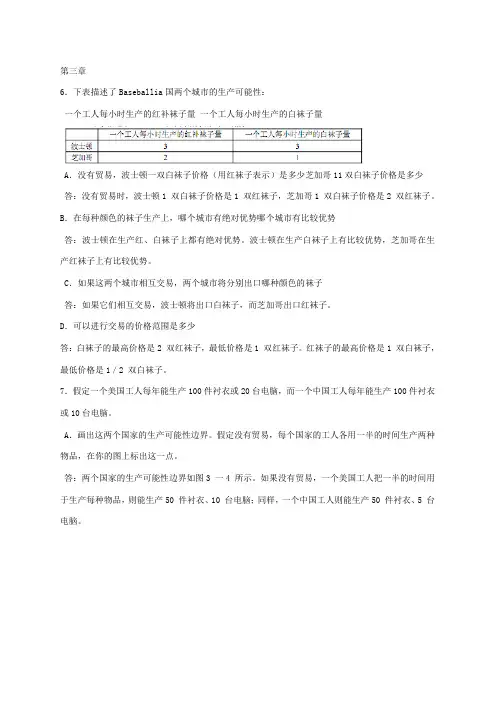
第三章6.下表描述了Baseballia国两个城市的生产可能性:一个工人每小时生产的红补袜子量一个工人每小时生产的白袜子量A.没有贸易,波士顿一双白袜子价格(用红袜子表示)是多少芝加哥11双白袜子价格是多少答:没有贸易时,波士顿1 双白袜子价格是1 双红袜子,芝加哥1 双白袜子价格是2 双红袜子。
B.在每种颜色的袜子生产上,哪个城市有绝对优势哪个城市有比较优势答:波士顿在生产红、白袜子上都有绝对优势。
波士顿在生产白袜子上有比较优势,芝加哥在生产红袜子上有比较优势。
C.如果这两个城市相互交易,两个城市将分别出口哪种颜色的袜子答:如果它们相互交易,波士顿将出口白袜子,而芝加哥出口红袜子。
D.可以进行交易的价格范围是多少答:白袜子的最高价格是2 双红袜子,最低价格是1 双红袜子。
红袜子的最高价格是1 双白袜子,最低价格是1/2 双白袜子。
7.假定一个美国工人每年能生产100件衬衣或20台电脑,而一个中国工人每年能生产100件衬衣或10台电脑。
A.画出这两个国家的生产可能性边界。
假定没有贸易,每个国家的工人各用一半的时间生产两种物品,在你的图上标出这一点。
答:两个国家的生产可能性边界如图3 一4 所示。
如果没有贸易,一个美国工人把一半的时间用于生产每种物品,则能生产50 件衬衣、10 台电脑;同样,一个中国工人则能生产50 件衬衣、5 台电脑。
图3 一4 生产可能性边界B.如果这两个国家进行贸易,哪个国家将出口衬衣举出一个具体的数字例子,并在你的图上标出。
哪一个国家将从贸易中获益解释原因。
答:中国将出口衬衣。
对美国而言,生产一台电脑的机会成本是5 件衬衣,而生产一件衬衣的机会成本为1/5 台电脑。
对中国而言,生产一台电脑的机会成本是10 件衬衣,而生产一件衬衣的机会成本为1/10 台电脑。
因此,美国在生产电脑上有比较优势,中国在生产衬衣上有比较优势,所以中国将出口衬衣。
衬衣的价格在1/5 到1/10 台电脑之间。
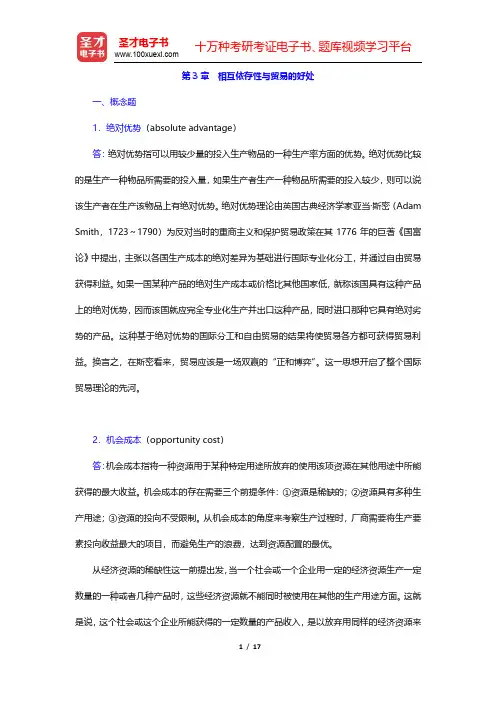
第3章相互依存性与贸易的好处一、概念题1.绝对优势(absolute advantage)答:绝对优势指可以用较少量的投入生产物品的一种生产率方面的优势。
绝对优势比较的是生产一种物品所需要的投入量,如果生产者生产一种物品所需要的投入较少,则可以说该生产者在生产该物品上有绝对优势。
绝对优势理论由英国古典经济学家亚当·斯密(Adam Smith,1723~1790)为反对当时的重商主义和保护贸易政策在其1776年的巨著《国富论》中提出,主张以各国生产成本的绝对差异为基础进行国际专业化分工,并通过自由贸易获得利益。
如果一国某种产品的绝对生产成本或价格比其他国家低,就称该国具有这种产品上的绝对优势,因而该国就应完全专业化生产并出口这种产品,同时进口那种它具有绝对劣势的产品。
这种基于绝对优势的国际分工和自由贸易的结果将使贸易各方都可获得贸易利益。
换言之,在斯密看来,贸易应该是一场双赢的“正和博弈”。
这一思想开启了整个国际贸易理论的先河。
2.机会成本(opportunity cost)答:机会成本指将一种资源用于某种特定用途所放弃的使用该项资源在其他用途中所能获得的最大收益。
机会成本的存在需要三个前提条件:①资源是稀缺的;②资源具有多种生产用途;③资源的投向不受限制。
从机会成本的角度来考察生产过程时,厂商需要将生产要素投向收益最大的项目,而避免生产的浪费,达到资源配置的最优。
从经济资源的稀缺性这一前提出发,当一个社会或一个企业用一定的经济资源生产一定数量的一种或者几种产品时,这些经济资源就不能同时被使用在其他的生产用途方面。
这就是说,这个社会或这个企业所能获得的一定数量的产品收入,是以放弃用同样的经济资源来生产其他产品时所能获得的收入作为代价的,这也是机会成本产生的缘由。
因此,社会生产某种产品的真正成本就是它不能生产另一些产品的代价。
所以,机会成本的含义是:任何生产资源或生产要素一般都有多种不同的使用途径或机会,也就是说可以用于多种产品的生产。
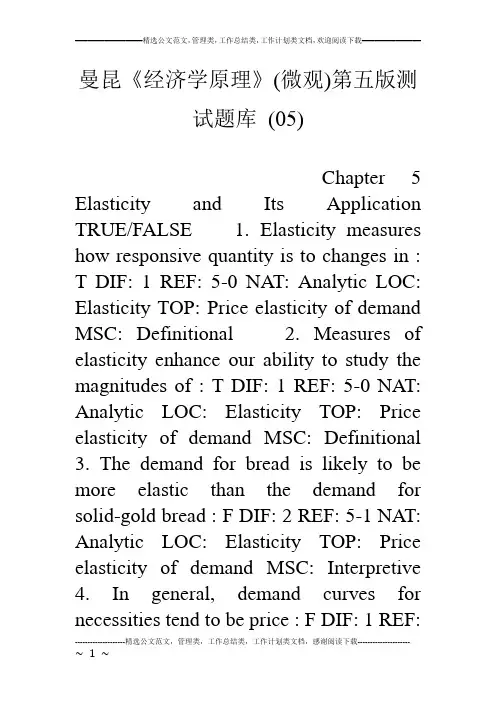
曼昆《经济学原理》(微观)第五版测试题库(05)Chapter 5 Elasticity and Its Application TRUE/FALSE 1. Elasticity measures how responsive quantity is to changes in : T DIF: 1 REF: 5-0 NAT: Analytic LOC: Elasticity TOP: Price elasticity of demand MSC: Definitional 2. Measures of elasticity enhance our ability to study the magnitudes of : T DIF: 1 REF: 5-0 NAT: Analytic LOC: Elasticity TOP: Price elasticity of demand MSC: Definitional 3. The demand for bread is likely to be more elastic than the demand for solid-gold bread : F DIF: 2 REF: 5-1 NAT: Analytic LOC: Elasticity TOP: Price elasticity of demand MSC: Interpretive 4. In general, demand curves for necessities tend to be price : F DIF: 1 REF:5-1 LOC: Elasticity TOP: Price elasticity of demand 5. In general, demand curves for luxuries tend to be price : T DIF: 1 REF: 5-1 LOC: Elasticity TOP: Price elasticity of demand NAT: Analytic MSC: InterpretiveNAT: Analytic MSC: Interpretive 6. Necessities tend to have inelastic demands, whereas luxuries have elastic : T DIF: 2 REF: 5-1 NAT: Analytic LOC: Elasticity TOP: Price elasticity of demand MSC: Interpretive7. Goods with close substitutes tend to have more elastic demands than do goods without close : T DIF: 2 REF: 5-1 NAT: Analytic LOC: Elasticity TOP: Price elasticity of demand MSC: Interpretive8. The demand for Rice Krispies is more elastic than the demand for cereal in : T DIF: 2 REF: 5-1 NAT: Analytic LOC: Elasticity TOP: Price elasticity of demand MSC: Interpretive9. The demand for soap is more elastic than the demand for Dove : FDIF: 2 REF: 5-1 NAT: Analytic LOC: Elasticity TOP: Price elasticity of demand MSC: Interpretive10. The demand for gasoline will respond more to a change in price over a period of five weeks than over a period of five : F DIF: 2 REF: 5-1 NAT: Analytic LOC: Elasticity TOP: Price elasticity of demand MSC: Interpretive 11. Even the demand for a necessity such as gasoline will respond to a change in price, especially over a longer time : T DIF: 2 REF: 5-1 NAT: Analytic LOC: Elasticity TOP: Price elasticity of demand MSC: Interpretive12. The price elasticity of demand is defined as the percentage change in quantity demanded divided by the percentage change in : T DIF: 1 REF: 5-1 NAT: Analytic LOC: Elasticity TOP: Price elasticity of demand MSC: Definitional13. The price elasticity of demand is defined as the percentage change in price divided by thepercentage change in quantity : F DIF: 1 REF: 5-1 NAT: Analytic LOC: Elasticity TOP: Price elasticity of demand MSC: Definitional288 Chapter 5 /Elasticity and Its Application ? 289 14. Suppose that when the price rises by 20% for a particular good, the quantity demanded of that good falls by 10%. The price elasticity of demand for this good is equal to : F DIF: 2 REF: 5-1 NAT: Analytic LOC: Elasticity TOP: Price elasticity of demand MSC: Analytical 15. Suppose that when the price rises by 10% for a particular good, the quantity demanded of that good falls by 20%. The price elasticity of demand for this good is equal to : T DIF: 2 REF: 5-1 NAT: Analytic LOC: Elasticity TOP: Price elasticity of demand MSC: Analytical 16. If the price of calculators increases by 15 percent and the quantity demanded per week falls by 45 percent as a result,then the price elasticity of demand is : T DIF: 2 REF: 5-1 NAT: Analytic LOC: Elasticity TOP: Price elasticity of demand MSC: Applicative17. Demand is inelastic if the price elasticity of demand is greater than : F DIF: 1 REF: 5-1 NAT: Analytic LOC: Elasticity TOP: Inelastic demand MSC: Definitional18. A linear, downward-sloping demand curve has a constant elasticity but a changing : F DIF: 2 REF: 5-1 NAT: Analytic LOC: Elasticity TOP: Price elasticity of demand MSC: Interpretive19. Price elasticity of demand along a linear, downward-sloping demand curve increases as price : F DIF: 3 REF: 5-1 NAT: Analytic LOC: Elasticity TOP: Price elasticity of demand MSC: Interpretive 20. If the price elasticity of demand is equal to 0, then demand is unit : F DIF: 1 REF: 5-1 NAT: Analytic LOC: Elasticity TOP: Price elasticity of demand MSC:Definitional21. If the price elasticity of demand is equal to 1, then demand is unit : T DIF: 1 REF: 5-1 NAT: Analytic LOC: Elasticity TOP: Price elasticity of demand MSC: Definitional22. Demand for a good is said to be inelastic if the quantity demanded increases substantially when the price falls by a small : F DIF: 1 REF: 5-1 NAT: Analytic LOC: Elasticity TOP: Inelastic demand MSC: Definitional23. The midpoint method is used to calculate elasticity between two points because it gives the same answer regardless of the direction of the : T DIF: 2 REF: 5-1 NAT: Analytic LOC: Elasticity TOP: Midpoint method MSC: Interpretive24. The flatter the demand curve that passes through a given point, the more inelastic the : F DIF: 2 REF: 5-1 NAT: Analytic LOC: Elasticity TOP: Price elasticity of demand MSC: Interpretive25. Theflatter the demand curve that passes through a given point, the more elastic the : T DIF: 2 REF: 5-1 NAT: Analytic LOC: Elasticity TOP: Price elasticity of demand MSC: Interpretive26. If demand is perfectly inelastic, the demand curve is vertical, and the price elasticity of demand equals : T DIF: 2 REF: 5-1 NAT: Analytic LOC: Elasticity TOP: Perfectly inelastic demand MSC: Interpretive27. If demand is perfectly elastic, the demand curve is horizontal, and the price elasticity of demand equals : F DIF: 2 REF: 5-1 NAT: Analytic LOC: Elasticity TOP: Perfectly elastic demand MSC: Interpretive290 ? Chapter 5 /Elasticity and Its Application 28. Along the elastic portion of a linear demand curve, total revenue rises as price : F DIF: 3 REF: 5-1 NAT: Analytic LOC: Elasticity TOP: Total revenue | Price elasticity of demand MSC: Interpretive29. If a firm is facing elastic demand, then the firm should decrease price to increase : T DIF: 2 REF: 5-1 NAT: Analytic LOC: Elasticity TOP: Total revenue | Price elasticity of demand MSC: Applicative 30. If a firm is facing inelastic demand, then the firm should decrease price to increase : F DIF: 2 REF: 5-1 NAT: Analytic LOC: Elasticity TOP: Total revenue | Price elasticity of demand MSC: Applicative31. When demand is inelastic, a decrease in price increases total : F DIF: 2 REF: 5-1 NAT: Analytic LOC: Elasticity TOP: Inelastic demand | Total revenue MSC: Interpretive32. The income elasticity of demand is defined as the percentage change in quantity demanded divided by the percentage change in : T DIF: 1 REF: 5-1 NAT: Analytic LOC: Elasticity TOP: Income elasticity of demand MSC: Definitional 33. The income elasticity of demand isdefined as the percentage change in quantity demanded divided by the percentage change in : F DIF: 1 REF: 5-1 NAT: Analytic LOC: Elasticity TOP: Income elasticity of demand MSC: Definitional34. Normal goods have negative income elasticities of demand, while inferior goods have positive income elasticities of : F DIF: 2 REF: 5-1 NAT: Analytic LOC: Elasticity TOP: Income elasticity of demand MSC: Interpretive 35. If the income elasticity of demand for a good is negative, then the good must be an inferior : T DIF: 1 REF: 5-1 NAT: Analytic LOC: Elasticity TOP: Income elasticity of demand MSC: Interpretive36. If the cross-price elasticity of demand for two goods is negative, then the two goods are : F DIF: 2 REF: 5-1 NAT: Analytic LOC: Elasticity TOP: Cross-price elasticity of demand MSC: Interpretive37. If the cross-price elasticity of demand for twogoods is negative, then the two goods are : T DIF: 2 REF: 5-1 NAT: Analytic LOC: Elasticity TOP: Cross-price elasticity of demand MSC: Interpretive38. Cross-price elasticity of demand measures how the quantity demanded of one good changes as the price of another good : T DIF: 1 REF: 5-1 NAT: Analytic LOC: Elasticity TOP: Cross-price elasticity of demand MSC: Definitional39. Cross-price elasticity is used to determine whether goods are inferior or normal : F DIF: 2 REF: 5-1 NAT: Analytic LOC: Elasticity TOP: Cross-price elasticity of demand MSC: Interpretive40. Cross-price elasticity is used to determine whether goods are substitutes or : T DIF: 2 REF: 5-1 NAT: Analytic LOC: Elasticity TOP: Cross-price elasticity of demand MSC: Interpretive Chapter 5 /Elasticity and Its Application ? 291 41. The cross-price elasticity of garlic saltand onion salt is -2, which indicates that garlic salt and onion salt are : F DIF: 2 REF: 5-1 NAT: Analytic LOC: Elasticity TOP: Cross-price elasticity of demand MSC: Interpretive42. Price elasticity of supply measures how much the quantity supplied responds to changes in the : T DIF: 1 REF: 5-2 NAT: Analytic LOC: Elasticity TOP: Price elasticity of supply MSC: Definitional43. Supply and demand both tend to be more elastic in the long run and more inelastic in the short : T DIF: 2 REF: 5-1 | 5-2 NAT: Analytic LOC: Elasticity TOP: Price elasticities of demand and supply MSC: Interpretive 44. If the price elasticity of supply is 2 and the quantity supplied decreases by 6%, then the price must have decreased by 3%.ANS: T DIF: 2 REF: 5-2 NAT: Analytic LOC: Elasticity TOP: Price elasticity of supply MSC: Applicative 45. Supply is said to be inelastic if thequantity supplied responds substantially to changes in the price, and elastic if the quantity supplied responds only slightly to : F DIF: 1 REF: 5-2 NAT: Analytic LOC: Elasticity TOP: Price elasticity of supply MSC: Definitional46. Supply tends to be more elastic in the short run and more inelastic in the long : F DIF: 2 REF: 5-2 NAT: Analytic TOP: Price elasticity of supply MSC: Interpretive47. When the price of knee braces increased by 25 percent, the Brace Yourself Company increased its quantity supplied of knee braces per week by 75 percent. BYC’s price elasticity of supply of knee braces is : F DIF: 2 REF: 5-2 NAT: Analytic LOC: Elasticity TOP: Price elasticity of supply MSC: Applicative 48. If a supply curve is horizontal, then supply is said to be perfectly elastic, and the price elasticity of supply approaches : T DIF: 2 REF: 5-2 NAT:Analytic LOC: Elasticity TOP: Perfectly elastic supply MSC: Interpretive49. A government program that reduces land under cultivation hurts farmers but helps : F DIF: 2 REF: 5-3 NAT: Analytic LOC: Elasticity TOP: Total revenue MSC: Applicative50. OPEC failed to maintain a high price of oil in the long run, partly because both the supply of oil and the demand for oil are more elastic in the long run than in the short : T DIF: 2 REF: 5-3 NAT: Analytic LOC: Elasticity TOP: OPEC | Price elasticity of demand | Price elasticity of supply MSC: Applicative51. Drug interdiction, which reduces the supply of drugs, may decrease drug-related crime because the demand for drugs is : F DIF: 2 REF: 5-3 NAT: Analytic LOC: Elasticity TOP: Price elasticity of demand MSC: Applicative292 ? Chapter 5 /Elasticity and Its ApplicationSHORT ANSWER1. Consider the following pairs of goods. For which of the two goods would you expect the demand to be more price elastic? Why? a. water or diamonds b. insulin or nasal decongestant spray c. food in general or breakfast cereal d. gasoline over the course of a week or gasoline over the course of a year e. personal computers or IBM personal computers ANS: a. Diamonds are luxuries, and water is a necessity. Therefore, diamonds have the more elastic demand. b. Insulin has no close substitutes, but decongestant spray does. Therefore, nasal decongestant spray has the more elastic demand. c. Breakfast cereal has more substitutes than does food in general. Therefore, breakfast cereal has the more elastic demand.d. The longer the time period, the more elastic demand is. Therefore, gasoline over the course of a year has the moreelastic demand. e. There are more substitutes for IBM personal computers than there are for personal computers. Therefore, IBM personal computers have the more elastic demand. DIF: 2 REF: 5-1 TOP: Price elasticity of demand NAT: Analytic MSC: Applicative LOC: ElasticityChapter 5 /Elasticity and Its Application ? 293 2. You own a small town movie theatre. You currently charge $5 per ticket for everyone who comes to your movies. Your friend who took an economics course in college tells you that there may be a way to increase your total revenue. Given the demand curves shown, answer the following questions. 10987654321102030405060708090100Qu antityPriceAdult Demand 10987654321510152025303540455055606570QuantityPriceChild Demanda. b. c. d.e. f. What is your current total revenue for both groups? The elasticity of demand is more elastic in which market? Which market has the more inelastic demand? What is the elasticity of demand between the prices of $5 and $2 in the adult market? Is this elastic or inelastic? What is the elasticity of demand between $5 and $2 in the children’s market? Is this elastic or inelastic? Given the graphs and what your friend knows about economics, he recommends you increase the price of adult tickets to $8 each and lower the price of a child’s ticket to $3. How much could you increase total revenue if you take his advice? ANS: a. Total revenue from children’s tickets is $100 and from adult tickets is $250. Total revenue from all sales would be $350. b. The demand for children’s tickets is moreelastic. c. The adult ticket market has the more inelastic demand. d. The elasticity of demand between $5 and $2 is , which is inelastic. e. The elasticity of demand between $5 and $2 is , which is unit elastic. f. Total revenue in the adult market would be $320. Total revenue in the children’s market would be $120, so total revenue for both groups would be $440. $440 - $350 is an increase in total revenue of $90. DIF: 2 REF: 5-1 NAT: Analytic TOP: Price elasticity of demand | Total revenue LOC: Elasticity MSC: Applicative 294 ? Chapter 5 /Elasticity and Its Application 3. Use the graph shown to answer the following questions. Put the correct letter(s) in the blank. APriceBDemandCQuantity a.b. c. d. The elastic section of the graph is represented by section from _______. The inelastic section of the graphis represented by section from _______. The unit elastic section of the graph is represented by section _______. The portion of the graph in which a decrease in price would cause total revenue to fall would be from _________. e. The portion of the graph in which a decrease in price would cause total revenue to rise would be from _________. f. The portion of the graph in which a decrease in price would not cause a change in total revenue would be _________. g. The section of the graph in which total revenue would be at a maximum would be _______. h. The section of the graph in which elasticity is greater than 1 is _______. i. The section of the graph in which elasticity is equal to 1 is ______. j. The section of the graph in which elasticity is less than 1 is _______.A toB B toC B B to C A to B B B A to BB B toC LOC: Elasticity MSC:Applicative ANS: a. b. c. d. e. f.g. h. i. j. DIF: 2 REF: 5-1 NAT: Analytic TOP: Price elasticity of demand | Total revenue Chapter 5 /Elasticity and Its Application ? 295 4. Using the midpoint method, compute the elasticity of demand between points A and B. Is demand along this portion of the curve elastic or inelastic? Interpret your answer with regard to price and quantity demanded. Now compute the elasticity of demand between points B and C. Is demand along this portion of the curve elastic or inelastic? Price222018161412108642CBADemand1 00200300400500600700800900QuantityA NS: In the section of the demand curve from A to B, the elasticity of demand would be This would be an elastic portion of the curve. This would mean that for every 1 percent change in price, quantity demanded would change bypercent. In the section of the demand curve from B to C, the elasticity of demand would be .75. This would be an inelastic portion of the curve. This would mean that for every 1 percent change in price, quantity demanded would change by percent.DIF: 2 REF: 5-1 TOP: Price elasticity of demand 5. NAT: Analytic MSC: Applicative LOC: Elasticity When the Shaffers had a monthly income of $4,000, they usually ate out 8 times a month. Now that the couple makes $4,500 a month, they eat out 10 times a month. Compute the couple’s income elasticity of demand using the midpoint method. Explain your answer. (Is a restaurant meal a normal or inferior good to the couple?)ANS: The income elasticity of demand for the Shaffers is Since the income elasticity of demand is positive, eating out would be interpreted as a normal good.DIF: 2 REF: 5-1 TOP:Income elasticity of demand 6. NAT: Analytic MSC: Applicative LOC: Elasticity Recently, in Smalltown, the price of Twinkies fell from $ to $ As a result, the quantity demanded of Ho-Ho’s decreased from 120 to 100. What would be the appropriate elasticity to compute? Using the midpoint method, compute this elasticity. What does your answer tell you?ANS: The appropriate elasticity to compute would be cross-price elasticity. The cross-price elasticity for this example would be The two goods are substitutes because the cross-price elasticity is positive.DIF: 2 REF: 5-1 TOP: Cross-price elasticity of demand NAT: Analytic MSC: Applicative LOC: Elasticity 296 ? Chapter 5 /Elasticity and Its Application Sec00 - Elasticity and Its Application MULTIPLE CHOICE1. In general, elasticity is a measure of a. the extentto which advances in technology are adopted by producers. b. the extent to which a market is competitive. c. how firms’profits respond to changes in market prices. d. how much buyers and sellers respond to changes in market conditions. DIF: 1 LOC: Elasticity REF: 5-0 TOP: Elasticity MSC: Definitional ANS: D NAT: Analytic 2. Elasticity is a. a measure of how much buyers and sellers respond to changes in market conditions. b. the study of how the allocation of resources affects economic well-being. c. the maximum amount that a buyer will pay for a good.d. the value of everything a seller must give up to produce a good. DIF: 1 LOC: Elasticity REF: 5-0 TOP: Elasticity MSC: Definitional ANS: A NAT: Analytic 3. When studying how some event or policyaffects a market, elasticity provides information on the a. equity effects on the market by identifying the winners and losers. b. magnitude of the effect on the market. c. speed of adjustment of the market in response to the event or policy.d. number of market participants who are directly affected by the event or policy. DIF: 2 LOC: Elasticity REF: 5-0 TOP: Elasticity MSC: Interpretive ANS: B NAT: Analytic 4. How does the concept of elasticity allow us to improve upon our understanding of supply and demand? a. Elasticity allows us to analyze supply and demand with greater precision than would be the case in the absence of the elasticity concept. b. Elasticity provides us with a better rationale for statements such as “an increase in x will lead to a decrease in y” than we would have in the absence of the elasticityconcept. c. Without elasticity, we would not be able to address the direction in which price is likely to move in response to a surplus or a shortage. d. Without elasticity, it is very difficult to assess the degree of competition within a market. DIF: 2 LOC: Elasticity REF: 5-0 TOP: Elasticity MSC: Interpretive ANS: A NAT: Analytic 5. When consumers face rising gasoline prices, they typically a. reduce their quantity demanded more in the long run than in the short run. b. reduce their quantity demanded more in the short run than in the long run. c. do not reduce their quantity demanded in the short run or the long run. d. increase their quantity demanded in the short run but reduce their quantity demanded in the long run. DIF: 2 LOC: Elasticity REF: 5-0 TOP: Elasticity MSC: Applicative ANS: A NAT:Analytic 6. A 10 percent increase in gasoline prices reduces gasoline consumption by about a. 6 percent after one year and percent after five years. b. percent after one year and 6 percent after five years. c. 10 percent after one year and 20 percent after five years. d. 0 percent after one year and 1 percent after five years. DIF: 2 LOC: Elasticity REF: 5-0 TOP: Elasticity MSC: Applicative ANS: B NAT: Analytic Chapter 5 /Elasticity and Its Application ? 297 7. Which of the following statements about the consumers’responses to rising gasoline prices is correct? a. About 10 percent of the long-run reduction in quantity demanded arises because people drive less and about 90 percent arises because they switch to more fuel-efficient cars. b. About 90 percent of the long-run reduction in quantity demanded arises becausepeople drive less and about 10 percent arises because they switch to more fuel-efficient cars. c. About half of the long-run reduction in quantity demanded arises because people drive less and about half arises because they switch to more fuel-efficient cars. d. Because gasoline is a necessity, consumers do not decrease their quantity demanded in either the short run or the long run. DIF: 2 LOC: Elasticity REF: 5-0 TOP: Elasticity MSC: Applicative ANS: C NAT: Analytic Sec01 - Elasticity and Its Application - The Elasticity of Demand MULTIPLE CHOICE1. The price elasticity of demand measures how much a. quantity demanded responds to a change in price. b. quantity demanded responds to a change in income. c. price responds to a change in demand. d. demand responds to a change in supply. DIF: 1 LOC:Elasticity ANS: A NAT: Analytic MSC: Definitional2. REF: 5-1 TOP: Price elasticity of demand The price elasticity of demand measures a. buyers’responsiveness to a change in the price of a good. b. the extent to which demand increases as additional buyers enter the market. c. how much more of a good consumers will demand when incomes rise. d. the movement along a supply curve when there is a change in demand. DIF: 1 LOC: Elasticity ANS: A NAT: Analytic MSC: Definitional3. REF: 5-1 TOP: Price elasticity of demand The price elasticity of demand for a good measures the willingness of a. consumers to buy less of the good as price rises.b. consumers to avoid monopolistic markets in favor of competitive markets.c. firms to produce more of a good as price rises.d. firms to cater to the tastes ofconsumers. DIF: 1 LOC: Elasticity ANS: A NAT: Analytic MSC: Interpretive4. REF: 5-1 TOP: Price elasticity of demand Which of the following statements about the price elasticity of demand is correct?a. The price elasticity of demand for a good measures the willingness of buyers of the good to buy less of the good as its price increases.b. Price elasticity of demand reflects the many economic, psychological, and social forces that shape consumer tastes.c. Other things equal, if good x has close substitutes and good y does not have close substitutes, then the demand for good x will be more elastic than the demand for good y.d. All of the above are correct. DIF: 2 LOC: Elasticity ANS: D NAT: Analytic MSC: Interpretive REF: 5-1 TOP: Price elasticity of demand308 ? Chapter 5 /Elasticity and Its Application Figure 5-2 PricePaPbD1D3D2Quantity59. Refer to Figure 5-2. As price falls from Pa to Pb, which demand curve represents the most elastic demand? a. D1 b. D2 c. D3 d. All of the above are equally elastic. ANS: A NAT: Analytic MSC: Applicative DIF: 2 LOC: Elasticity REF: 5-1 TOP: Price elasticity of demand 60. Refer to Figure 5-2. As price falls from Pa to Pb, we could use the three demand curves to calculate three different values of the price elasticity of demand. Which of the three demand curves would produce the smallest elasticity? a. D1 b. D2 c. D3 d. All of the above are equally elastic. ANS: C NAT: Analytic MSC: Applicative DIF: 2 LOC:Elasticity REF: 5-1 TOP: Price elasticity of demand Table 5-1 Good Price Elasticity of Demand A B 61. Refer to Table 5-1. Which of the following is consistent with the elasticities given in Table 5-2? a. A is a luxury and B is a necessity. b. A is a good several years after a price increase, and B is that same good several days after the price increase. c. A is a Kit Kat bar and B is candy. d. A has fewer substitutes than B. ANS: D NAT: Analytic MSC: Analytical DIF: 3 LOC: Elasticity REF: 5-1 TOP: Price elasticity of demand Chapter 5 /Elasticity and Its Application ? 309 62. Refer to Table 5-1. Which of the following is consistent with the elasticities given in Table 5-2? a. A is grapes and B is fruit. b. A is T-shirts and B is socks.c. A is train tickets before cars were invented, and B is train tickets after carswere invented. d. A is diamond necklaces and B is beds. ANS: C NAT: Analytic MSC: Analytical DIF: 3 LOC: Elasticity REF: 5-1 TOP: Price elasticity of demand 63. Studies indicate that the price elasticity of demand for cigarettes is about A government policy aimed at reducing smoking changed the price of a pack of cigarettes from $2 to $6. According to the midpoint method, the government policy should have reduced smoking by a. 30%. b. 40%. c. 80%. d. 250%. ANS: B NAT: Analytic MSC: Applicative DIF: 3 LOC: Elasticity REF: 5-1 TOP: Price elasticity of demand 64. If a 15% increase in price for a good results in a 20% decrease in quantity demanded, the price elasticity of demand is a. b. c. d. ANS: C NAT: Analytic MSC: Analytical DIF: 2 LOC: Elasticity REF: 5-1TOP: Price elasticity of demand 65. If a 20% increase in price for a good results in a 15% decrease in quantity demanded, the price elasticity of demand is a. b. c. d. ANS: A NAT: Analytic MSC: Analytical DIF: 2 LOC: Elasticity REF: 5-1 TOP: Price elasticity of demand 66. If a 10% decrease in price for a good results in a 20% increase in quantity demanded, the price elasticity of demand is a. b. 1. c. d. 2. ANS: D NAT: Analytic MSC: Analytical DIF: 2 LOC: Elasticity REF: 5-1 TOP: Price elasticity of demand 67. If a 6% decrease in price for a good results in a 2% increase in quantity demanded, the price elasticity of demand is a. b.c. 3.d. 4. ANS: B NAT: Analytic MSC: Analytical DIF: 2 LOC: Elasticity REF: 5-1 TOP: Price elasticity of demand 310 ?Chapter 5 /Elasticity and Its Application 68. Suppose that quantity demand rises by 10% as a result of a 15% decrease in price. The price elasticity of demand for this good is a. inelastic and equal to b. elastic and equal to c. inelastic and equal to d. elastic and equal to ANS: A NAT: Analytic MSC: Analytical DIF: 2 LOC: Elasticity REF: 5-1 TOP: Price elasticity of demand 69. Suppose that quantity demand falls by 30% as a result of a 5% increase in price. The price elasticity of demand for this good is a. inelastic and equal to 6. b. elastic and equal to 6. c. inelastic and equal to d. elastic and equal to ANS: B NAT: Analytic MSC: Analytical DIF: 2 LOC: Elasticity REF: 5-1 TOP: Price elasticity of demand Table 5-2 The following table shows a portion of the demand schedule for aparticular good at various levels of income. Price $24 $20 $16 $12 $8 $4 Quantity Demanded (Income = $5,000) 2 4 6 8 10 12 Quantity Demanded (Income = $7,500) 3 6 9 12 15 18 Quantity Demanded (Income = $10,000) 4 8 12 16 20 24 70. Refer to Table 5-2. Using the midpoint method, when income equals $7,500, what is the price elasticity of demand between $16 and $20? a. b. c. d. ANS: D NAT: Analytic MSC: Analytical DIF: 2 LOC: Elasticity REF: 5-1 TOP: Price elasticity of demand 71. Refer to Table 5-2. Using the midpoint method, when income equals $5,000, what is the price elasticity of demand between $8 and $12? a. b. c. d. ANS: A NAT: Analytic MSC: Analytical DIF: 2 LOC: Elasticity REF: 5-1 TOP: Price elasticity of demand Chapter 5 /Elasticity and Its Application ?311 72. Refer to Table 5-2. Using the midpoint method, at a price of $16, what is the income elasticity of demand when income rises from $5,000 to $10,000?a. b. c. d. ANS: C NAT: Analytic MSC: Analytical DIF: 2 LOC: Elasticity REF: 5-1 TOP: Income elasticity of demand 73. Refer to Table 5-2. Using the midpoint method, at a price of $8, what is the income elasticity of demand when income rises from $7,500 to $10,000? a.b. c. d. ANS: C NAT: Analytic MSC: Analytical DIF: 2 LOC: Elasticity REF: 5-1 TOP: Income elasticity of demand 74. Refer to Table 5-2. Using the midpoint method, at a price of $12, what is the income elasticity of demand when income rises from $5,000 to $10,000? a.b. c. d. ANS: C NAT: Analytic MSC: Analytical DIF: 2。
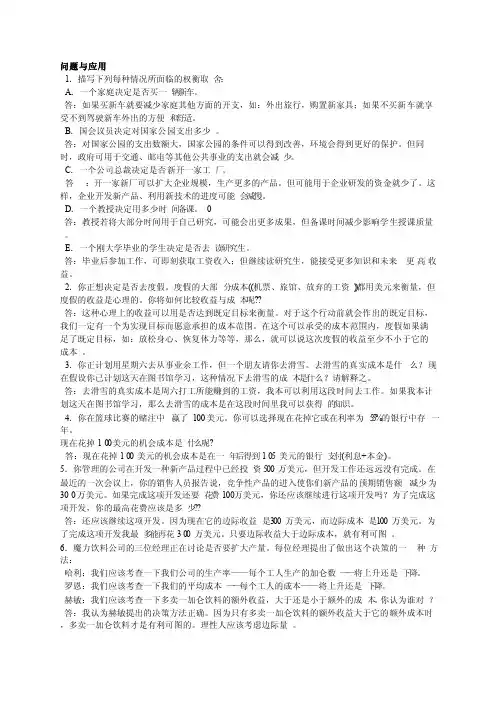
问题与应用1.描写下列每种情况所面临的权衡取舍:A.一个家庭决定是否买一辆新车。
答:如果买新车就要减少家庭其他方面的开支,如:外出旅行,购置新家具;如果不买新车就享受不到驾驶新车外出的方便和舒适。
B.国会议员决定对国家公园支出多少。
答:对国家公园的支出数额大,国家公园的条件可以得到改善,环境会得到更好的保护。
但同时,政府可用于交通、邮电等其他公共事业的支出就会减少。
C.一个公司总裁决定是否新开一家工厂。
答:开一家新厂可以扩大企业规模,生产更多的产品。
但可能用于企业研发的资金就少了。
这样,企业开发新产品、利用新技术的进度可能会减慢。
D.一个教授决定用多少时间备课。
0答:教授若将大部分时间用于自己研究,可能会出更多成果,但备课时间减少影响学生授课质量。
E.一个刚大学毕业的学生决定是否去读研究生。
答:毕业后参加工作,可即刻获取工资收入;但继续读研究生,能接受更多知识和未来更高收益。
2.你正想决定是否去度假。
度假的大部分成本((机票、旅馆、放弃的工资))都用美元来衡量,但度假的收益是心理的。
你将如何比较收益与成本呢??答:这种心理上的收益可以用是否达到既定目标来衡量。
对于这个行动前就会作出的既定目标,我们一定有一个为实现目标而愿意承担的成本范围。
在这个可以承受的成本范围内,度假如果满足了既定目标,如:放松身心、恢复体力等等,那么,就可以说这次度假的收益至少不小于它的成本。
3.你正计划用星期六去从事业余工作,但一个朋友请你去滑雪。
去滑雪的真实成本是什么?现在假设你已计划这天在图书馆学习,这种情况下去滑雪的成本是什么?请解释之。
答:去滑雪的真实成本是周六打工所能赚到的工资,我本可以利用这段时间去工作。
如果我本计划这天在图书馆学习,那么去滑雪的成本是在这段时间里我可以获得的知识。
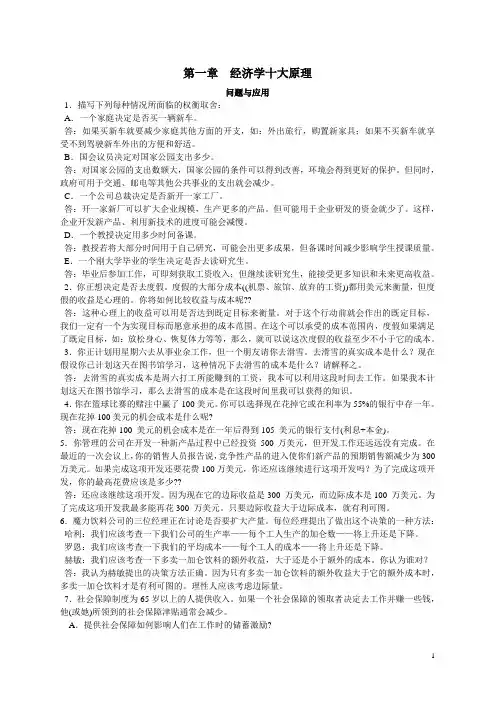
第一章经济学十大原理问题与应用1.描写下列每种情况所面临的权衡取舍:A.一个家庭决定是否买一辆新车。
答:如果买新车就要减少家庭其他方面的开支,如:外出旅行,购置新家具;如果不买新车就享受不到驾驶新车外出的方便和舒适。
B.国会议员决定对国家公园支出多少。
答:对国家公园的支出数额大,国家公园的条件可以得到改善,环境会得到更好的保护。
但同时,政府可用于交通、邮电等其他公共事业的支出就会减少。
C.一个公司总裁决定是否新开一家工厂。
答:开一家新厂可以扩大企业规模,生产更多的产品。
但可能用于企业研发的资金就少了。
这样,企业开发新产品、利用新技术的进度可能会减慢。
D.一个教授决定用多少时间备课。
答:教授若将大部分时间用于自己研究,可能会出更多成果,但备课时间减少影响学生授课质量。
E.一个刚大学毕业的学生决定是否去读研究生。
答:毕业后参加工作,可即刻获取工资收入;但继续读研究生,能接受更多知识和未来更高收益。
2.你正想决定是否去度假。
度假的大部分成本((机票、旅馆、放弃的工资))都用美元来衡量,但度假的收益是心理的。
你将如何比较收益与成本呢??答:这种心理上的收益可以用是否达到既定目标来衡量。
对于这个行动前就会作出的既定目标,我们一定有一个为实现目标而愿意承担的成本范围。
在这个可以承受的成本范围内,度假如果满足了既定目标,如:放松身心、恢复体力等等,那么,就可以说这次度假的收益至少不小于它的成本。
3.你正计划用星期六去从事业余工作,但一个朋友请你去滑雪。
去滑雪的真实成本是什么?现在假设你已计划这天在图书馆学习,这种情况下去滑雪的成本是什么?请解释之。
答:去滑雪的真实成本是周六打工所能赚到的工资,我本可以利用这段时间去工作。
如果我本计划这天在图书馆学习,那么去滑雪的成本是在这段时间里我可以获得的知识。
4.你在篮球比赛的赌注中赢了100美元。
你可以选择现在花掉它或在利率为55%的银行中存一年。
现在花掉100美元的机会成本是什么呢?答:现在花掉100 美元的机会成本是在一年后得到105 美元的银行支付(利息+本金)。
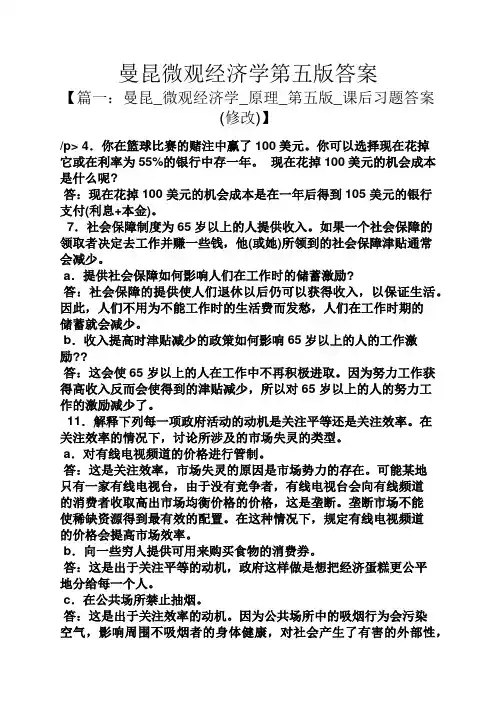
曼昆微观经济学第五版答案【篇一:曼昆_微观经济学_原理_第五版_课后习题答案(修改)】/p> 4.你在篮球比赛的赌注中赢了100美元。
你可以选择现在花掉它或在利率为55%的银行中存一年。
现在花掉100美元的机会成本是什么呢?答:现在花掉100 美元的机会成本是在一年后得到105 美元的银行支付(利息+本金)。
7.社会保障制度为65岁以上的人提供收入。
如果一个社会保障的领取者决定去工作并赚一些钱,他(或她)所领到的社会保障津贴通常会减少。
a.提供社会保障如何影响人们在工作时的储蓄激励?答:社会保障的提供使人们退休以后仍可以获得收入,以保证生活。
因此,人们不用为不能工作时的生活费而发愁,人们在工作时期的储蓄就会减少。
b.收入提高时津贴减少的政策如何影响65岁以上的人的工作激励??答:这会使65 岁以上的人在工作中不再积极进取。
因为努力工作获得高收入反而会使得到的津贴减少,所以对65 岁以上的人的努力工作的激励减少了。
11.解释下列每一项政府活动的动机是关注平等还是关注效率。
在关注效率的情况下,讨论所涉及的市场失灵的类型。
a.对有线电视频道的价格进行管制。
答:这是关注效率,市场失灵的原因是市场势力的存在。
可能某地只有一家有线电视台,由于没有竞争者,有线电视台会向有线频道的消费者收取高出市场均衡价格的价格,这是垄断。
垄断市场不能使稀缺资源得到最有效的配置。
在这种情况下,规定有线电视频道的价格会提高市场效率。
b.向一些穷人提供可用来购买食物的消费券。
答:这是出于关注平等的动机,政府这样做是想把经济蛋糕更公平地分给每一个人。
c.在公共场所禁止抽烟。
答:这是出于关注效率的动机。
因为公共场所中的吸烟行为会污染空气,影响周围不吸烟者的身体健康,对社会产生了有害的外部性,而外部性正是市场失灵的一种情况,而这也正是政府在公共场所禁止吸烟的原因。
d.把美孚石油公司(它曾拥90%的炼油厂)分拆为几个较小的公司。
答:出于关注效率的动机,市场失灵是由于市场势力。
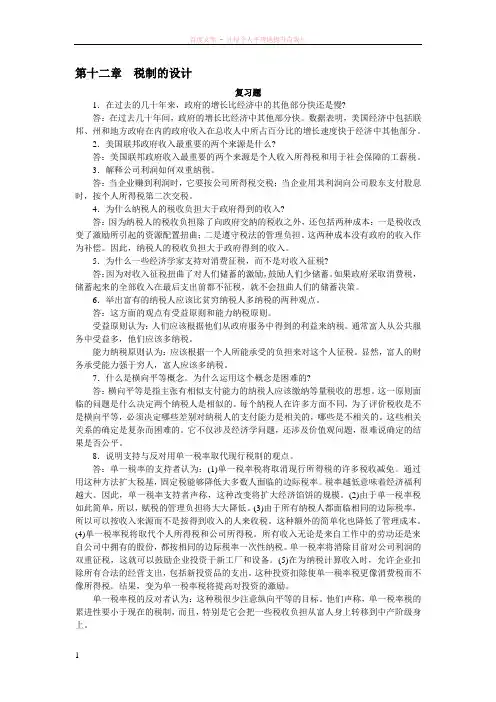
第十二章税制的设计复习题1.在过去的几十年来,政府的增长比经济中的其他部分快还是慢?答:在过去几十年间,政府的增长比经济中其他部分快。
数据表明,美国经济中包括联邦、州和地方政府在内的政府收入在总收人中所占百分比的增长速度快于经济中其他部分。
2.美国联邦政府收入最重要的两个来源是什么?答:美国联邦政府收入最重要的两个来源是个人收入所得税和用于社会保障的工薪税。
3.解释公司利润如何双重纳税。
答:当企业赚到利润时,它要按公司所得税交税;当企业用其利润向公司股东支付股息时,按个人所得税第二次交税。
4.为什么纳税人的税收负担大于政府得到的收入?答:因为纳税人的税收负担除了向政府交纳的税收之外,还包括两种成本:一是税收改变了激励所引起的资源配置扭曲;二是遵守税法的管理负担。
这两种成本没有政府的收入作为补偿。
因此,纳税人的税收负担大于政府得到的收入。
5.为什么一些经济学家支持对消费征税,而不是对收入征税?答:因为对收入征税扭曲了对人们储蓄的激励,鼓励人们少储蓄。
如果政府采取消费税,储蓄起来的全部收入在最后支出前都不征税,就不会扭曲人们的储蓄决策。
6.举出富有的纳税人应该比贫穷纳税人多纳税的两种观点。
答:这方面的观点有受益原则和能力纳税原则。
受益原则认为:人们应该根据他们从政府服务中得到的利益来纳税。
通常富人从公共服务中受益多,他们应该多纳税。
能力纳税原则认为:应该根据一个人所能承受的负担来对这个人征税。
显然,富人的财务承受能力强于穷人,富人应该多纳税。
7.什么是横向平等概念。
为什么运用这个概念是困难的?答:横向平等是指主张有相似支付能力的纳税人应该缴纳等量税收的思想。
这一原则面临的问题是什么决定两个纳税人是相似的。
每个纳税人在许多方面不同,为了评价税收是不是横向平等,必须决定哪些差别对纳税人的支付能力是相关的,哪些是不相关的。
这些相关关系的确定是复杂而困难的。
它不仅涉及经济学问题,还涉及价值观问题,很难说确定的结果是否公平。
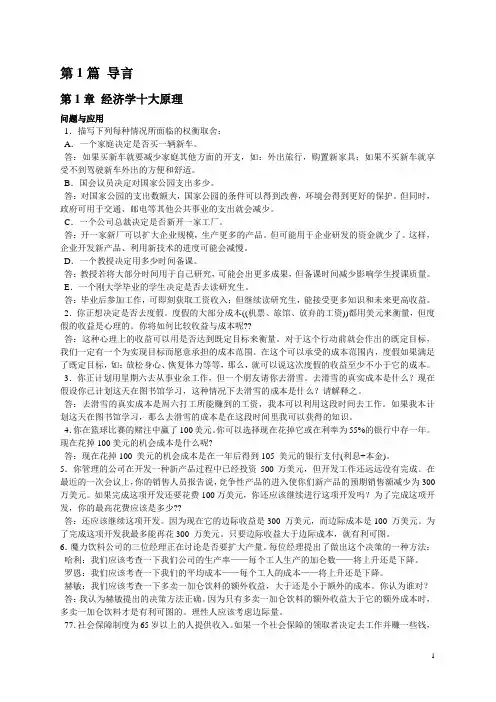
第1篇导言第1章经济学十大原理问题与应用1.描写下列每种情况所面临的权衡取舍:A.一个家庭决定是否买一辆新车。
答:如果买新车就要减少家庭其他方面的开支,如:外出旅行,购置新家具;如果不买新车就享受不到驾驶新车外出的方便和舒适。
B.国会议员决定对国家公园支出多少。
答:对国家公园的支出数额大,国家公园的条件可以得到改善,环境会得到更好的保护。
但同时,政府可用于交通、邮电等其他公共事业的支出就会减少。
C.一个公司总裁决定是否新开一家工厂。
答:开一家新厂可以扩大企业规模,生产更多的产品。
但可能用于企业研发的资金就少了。
这样,企业开发新产品、利用新技术的进度可能会减慢。
D.一个教授决定用多少时间备课。
答:教授若将大部分时间用于自己研究,可能会出更多成果,但备课时间减少影响学生授课质量。
E.一个刚大学毕业的学生决定是否去读研究生。
答:毕业后参加工作,可即刻获取工资收入;但继续读研究生,能接受更多知识和未来更高收益。
2.你正想决定是否去度假。
度假的大部分成本((机票、旅馆、放弃的工资))都用美元来衡量,但度假的收益是心理的。
你将如何比较收益与成本呢??答:这种心理上的收益可以用是否达到既定目标来衡量。
对于这个行动前就会作出的既定目标,我们一定有一个为实现目标而愿意承担的成本范围。
在这个可以承受的成本范围内,度假如果满足了既定目标,如:放松身心、恢复体力等等,那么,就可以说这次度假的收益至少不小于它的成本。
3.你正计划用星期六去从事业余工作,但一个朋友请你去滑雪。
去滑雪的真实成本是什么?现在假设你已计划这天在图书馆学习,这种情况下去滑雪的成本是什么?请解释之。
答:去滑雪的真实成本是周六打工所能赚到的工资,我本可以利用这段时间去工作。
如果我本计划这天在图书馆学习,那么去滑雪的成本是在这段时间里我可以获得的知识。
4.你在篮球比赛的赌注中赢了100美元。
你可以选择现在花掉它或在利率为55%的银行中存一年。
现在花掉100美元的机会成本是什么呢?答:现在花掉100 美元的机会成本是在一年后得到105 美元的银行支付(利息+本金)。
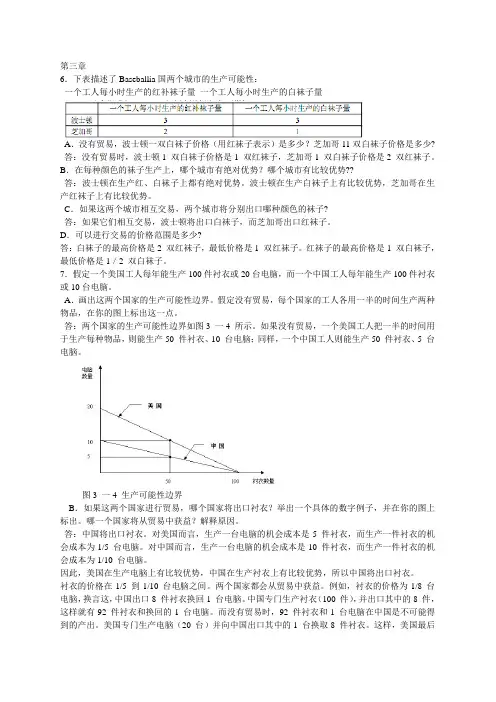
第三章6.下表描述了Baseballia国两个城市的生产可能性:一个工人每小时生产的红补袜子量一个工人每小时生产的白袜子量A.没有贸易,波士顿一双白袜子价格(用红袜子表示)是多少?芝加哥11双白袜子价格是多少? 答:没有贸易时,波士顿1 双白袜子价格是1 双红袜子,芝加哥1 双白袜子价格是2 双红袜子。
B.在每种颜色的袜子生产上,哪个城市有绝对优势?哪个城市有比较优势??答:波士顿在生产红、白袜子上都有绝对优势。
波士顿在生产白袜子上有比较优势,芝加哥在生产红袜子上有比较优势。
C.如果这两个城市相互交易,两个城市将分别出口哪种颜色的袜子?答:如果它们相互交易,波士顿将出口白袜子,而芝加哥出口红袜子。
D.可以进行交易的价格范围是多少?答:白袜子的最高价格是2 双红袜子,最低价格是1 双红袜子。
红袜子的最高价格是1 双白袜子,最低价格是1/2 双白袜子。
7.假定一个美国工人每年能生产100件衬衣或20台电脑,而一个中国工人每年能生产100件衬衣或10台电脑。
A.画出这两个国家的生产可能性边界。
假定没有贸易,每个国家的工人各用一半的时间生产两种物品,在你的图上标出这一点。
答:两个国家的生产可能性边界如图3 一4 所示。
如果没有贸易,一个美国工人把一半的时间用于生产每种物品,则能生产50 件衬衣、10 台电脑;同样,一个中国工人则能生产50 件衬衣、5 台电脑。
图3 一4 生产可能性边界B.如果这两个国家进行贸易,哪个国家将出口衬衣?举出一个具体的数字例子,并在你的图上标出。
哪一个国家将从贸易中获益?解释原因。
答:中国将出口衬衣。
对美国而言,生产一台电脑的机会成本是5 件衬衣,而生产一件衬衣的机会成本为1/5 台电脑。
对中国而言,生产一台电脑的机会成本是10 件衬衣,而生产一件衬衣的机会成本为1/10 台电脑。
因此,美国在生产电脑上有比较优势,中国在生产衬衣上有比较优势,所以中国将出口衬衣。
衬衣的价格在1/5 到1/10 台电脑之间。

第一章问题与应用4.你在篮球比赛的赌注中赢了100美元。
你可以选择现在花掉它或在利率为55%的银行中存一年。
现在花掉100美元的机会成本是什么呢?答:现在花掉100 美元的机会成本是在一年后得到105 美元的银行支付(利息+本金)。
7.社会保障制度为65岁以上的人提供收入。
如果一个社会保障的领取者决定去工作并赚一些钱,他(或她)所领到的社会保障津贴通常会减少。
A.提供社会保障如何影响人们在工作时的储蓄激励?答:社会保障的提供使人们退休以后仍可以获得收入,以保证生活。
因此,人们不用为不能工作时的生活费而发愁,人们在工作时期的储蓄就会减少。
B.收入提高时津贴减少的政策如何影响65岁以上的人的工作激励??答:这会使65 岁以上的人在工作中不再积极进取。
因为努力工作获得高收入反而会使得到的津贴减少,所以对65 岁以上的人的努力工作的激励减少了。
11.解释下列每一项政府活动的动机是关注平等还是关注效率。
在关注效率的情况下,讨论所涉及的市场失灵的类型。
A.对有线电视频道的价格进行管制。
答:这是关注效率,市场失灵的原因是市场势力的存在。
可能某地只有一家有线电视台,由于没有竞争者,有线电视台会向有线频道的消费者收取高出市场均衡价格的价格,这是垄断。
垄断市场不能使稀缺资源得到最有效的配置。
在这种情况下,规定有线电视频道的价格会提高市场效率。
B.向一些穷人提供可用来购买食物的消费券。
答:这是出于关注平等的动机,政府这样做是想把经济蛋糕更公平地分给每一个人。
C.在公共场所禁止抽烟。
答:这是出于关注效率的动机。
因为公共场所中的吸烟行为会污染空气,影响周围不吸烟者的身体健康,对社会产生了有害的外部性,而外部性正是市场失灵的一种情况,而这也正是政府在公共场所禁止吸烟的原因。
D.把美孚石油公司(它曾拥90%的炼油厂)分拆为几个较小的公司。
答:出于关注效率的动机,市场失灵是由于市场势力。
美孚石油公司在美国石油业中属于规模最大的公司之一,占有相当大的市场份额,很容易形成市场垄断。
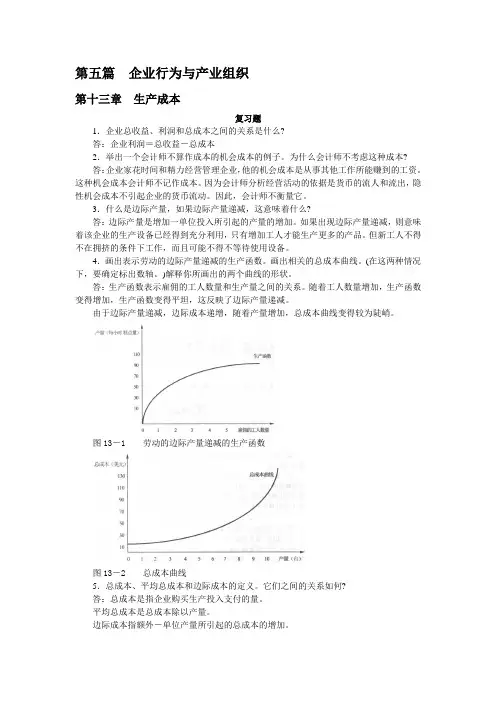
第五篇企业行为与产业组织第十三章生产成本复习题1.企业总收益、利润和总成本之间的关系是什么?答:企业利润=总收益-总成本2.举出一个会计师不算作成本的机会成本的例子。
为什么会计师不考虑这种成本?答:企业家花时间和精力经营管理企业,他的机会成本是从事其他工作所能赚到的工资。
这种机会成本会计师不记作成本。
因为会计师分析经营活动的依据是货币的流人和流出,隐性机会成本不引起企业的货币流动。
因此,会计师不衡量它。
3.什么是边际产量,如果边际产量递减,这意味着什么?答:边际产量是增加一单位投入所引起的产量的增加。
如果出现边际产量递减,则意味着该企业的生产设备已经得到充分利用,只有增加工人才能生产更多的产品。
但新工人不得不在拥挤的条件下工作,而且可能不得不等待使用设备。
4.画出表示劳动的边际产量递减的生产函数。
画出相关的总成本曲线。
(在这两种情况下,要确定标出数轴。
)解释你所画出的两个曲线的形状。
答:生产函数表示雇佣的工人数量和生产量之间的关系。
随着工人数量增加,生产函数变得增加,生产函数变得平坦,这反映了边际产量递减。
由于边际产量递减,边际成本递增,随着产量增加,总成本曲线变得较为陡峭。
图13-1 劳动的边际产量递减的生产函数图13-2 总成本曲线5.总成本、平均总成本和边际成本的定义。
它们之间的关系如何?答:总成本是指企业购买生产投入支付的量。
平均总成本是总成本除以产量。
边际成本指额外-单位产量所引起的总成本的增加。
平均总成本=总成本/产量边际成本=总成本变动量/产量变动量6.画出一个典型企业的边际成本和平均总成本曲线。
解释为什么这些曲线的形状是这样,以及为什么在某处相交。
答:图13-3 典型企业的边际成本和平均总成本典型企业的边际成本曲线呈U型。
因为企业在刚开始时,生产能力有剩余,增加一单位的投入量,边际产量会高于前一单位的投入,这样就出现一段边际成本下降。
生产能力全部被利用之后,再增加边际投入,就会出现边际产量递减,边际成本递增。
第一篇导言第一章经济学十大原理1.列举三个你在生活中面临的重要权衡取合的例子。
答:①大学毕业后.面临着是否继续深造的选择,选择继续上学攻读研究生学位,就意味着在今后三年中放弃参加工作、赚工资和积累社会经验的机会;2、在学习内容上也面临着很重要的权衡取舍,如果学习《经济学》,就要减少学习英语或其他专业课的时间,③对于不多的生活费的分配同样面临权衡取舍,要多买书.就要减少在吃饭、买衣服等其他方面的开支。
2、看一场电影的机会成本是什么?答:看一场电影的机会成本是在看电影的时间里做其他事情所能获得的最大收益,例如:看书、打零工。
3、水是生活必需的。
一杯水的边际利益是大还是小呢?答:这要看这杯水是在什么样的情况下喝.如果这是一个人五分钟内喝下的第五杯水.那么他的边际利益很小.有可能为负;如果这是一个极度干渴的人喝下的第一杯水,那么他的边际利益将会极大。
4、为什么决策者应该考虑激励?答:因为人们会对激励做出反应。
如果政策改变了激励,它将使人们改变自己的行为,当决策者未能考虑到行为如何由于政策的原因而变化时.他们的政策往往会产生意想不到的效果。
5 为什么各国之间的贸易不像竞赛一样有赢家和输家呢?答:因为贸易使各国可以专门从事自己最擅长的话动,并从中享有更多的各种各样的物品与劳务。
通过贸易使每个国家可供消费的物质财富增加,经济状况变得更好。
因此,各个贸易国之间既是竞争对手,又是经济合作伙伴。
在公平的贸易中是“双赢”或者“多赢”的结果。
6.市场巾的那只“看不见的手”在做什么呢,答:市场中那只“看不见的手”就是商品价格,价格反映商品自身的价值和社会成本,市场中的企业和家庭在作出买卖决策时都要关注价格。
因此.他们也会不自觉地考虑自己行为的(社会)收益和成本。
从而,这只“看不见的手”指引着干百万个体决策者在大多数情况下使社会福利趋向最大化。
7 解释市场失灵的两个主要原因,并各举出一个例子。
答:市场失灵的主要原因是外部性和市场势力。
第一篇导言第一章经济学十大原理1.列举三个你在生活中面临的重要权衡取合的例子。
答:①大学毕业后.面临着是否继续深造的选择,选择继续上学攻读研究生学位,就意味着在今后三年中放弃参加工作、赚工资和积累社会经验的机会;2、在学习内容上也面临着很重要的权衡取舍,如果学习《经济学》,就要减少学习英语或其他专业课的时间,③对于不多的生活费的分配同样面临权衡取舍,要多买书.就要减少在吃饭、买衣服等其他方面的开支。
2、看一场电影的机会成本是什么?答:看一场电影的机会成本是在看电影的时间里做其他事情所能获得的最大收益,例如:看书、打零工.3、水是生活必需的。
一杯水的边际利益是大还是小呢?答:这要看这杯水是在什么样的情况下喝.如果这是一个人五分钟内喝下的第五杯水.那么他的边际利益很小.有可能为负;如果这是一个极度干渴的人喝下的第一杯水,那么他的边际利益将会极大。
4、为什么决策者应该考虑激励?答:因为人们会对激励做出反应。
如果政策改变了激励,它将使人们改变自己的行为,当决策者未能考虑到行为如何由于政策的原因而变化时.他们的政策往往会产生意想不到的效果.5 为什么各国之间的贸易不像竞赛一样有赢家和输家呢?答:因为贸易使各国可以专门从事自己最擅长的话动,并从中享有更多的各种各样的物品与劳务。
通过贸易使每个国家可供消费的物质财富增加,经济状况变得更好。
因此,各个贸易国之间既是竞争对手,又是经济合作伙伴。
在公平的贸易中是“双赢"或者“多赢”的结果.6.市场巾的那只“看不见的手"在做什么呢,答:市场中那只“看不见的手”就是商品价格,价格反映商品自身的价值和社会成本,市场中的企业和家庭在作出买卖决策时都要关注价格.因此.他们也会不自觉地考虑自己行为的(社会)收益和成本.从而,这只“看不见的手"指引着干百万个体决策者在大多数情况下使社会福利趋向最大化.7 解释市场失灵的两个主要原因,并各举出一个例子。